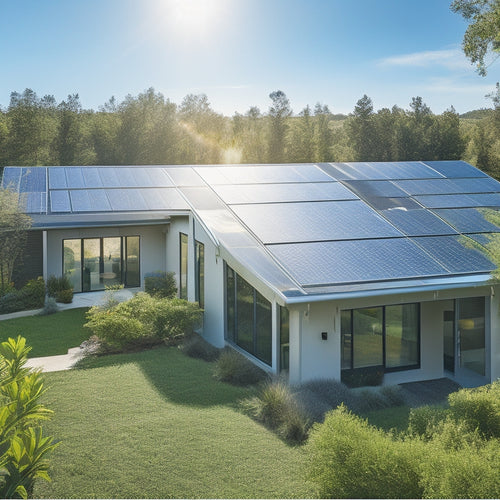
Most Efficient Solar Panels for Homes
Share
You're seeking the most efficient solar panels for your home, which means optimizing energy conversion rates, maximizing power output, and enhancing energy harvesting. Look for advanced photovoltaic cell technology, high-efficiency solar cells, and larger panels to maximize energy output. Max Power Point Tracking (MPPT) is also essential, as it optimizes energy harvesting and power conversion. Don't forget to take into account your roof size and ideal panel placement to guarantee maximum energy capture. By focusing on these key factors, you'll be well on your way to achieving energy independence and reaping the benefits of efficient solar panels - and there's more to investigate when it comes to revealing their full potential.
The Essentials
- Advanced photovoltaic cell technology improves energy conversion rates, generating more electricity from the same sunlight.
- High-efficiency solar cells convert a higher percentage of sunlight into usable electricity, maximizing power output and energy independence.
- Max Power Point Tracking (MPPT) optimizes energy harvesting and power conversion, increasing energy harvest by up to 30% compared to non-MPPT systems.
- Larger solar panels with higher wattage ratings lead to increased electricity generation per hour, essential for maximizing energy capture in low sunlight regions.
- Monocrystalline or bifacial panels can reach efficiencies of up to 23%, enabling better energy harvesting and maximum power output.
Higher Energy Conversion Rate
You're looking to maximize your solar panel's energy conversion rate to get the most out of your investment.
To achieve this, you'll want to focus on maximizing power output and optimizing energy harvesting. By leveraging advanced photovoltaic cell technology Renewable Energy, you can greatly improve energy conversion rates.
Additionally, with efficient photovoltaic systems, you can generate more electricity from the same amount of sunlight, making your solar panel system more efficient and cost-effective.
Maximum Power Output
With the advancement of solar panel technology, homeowners can now capture more energy from the sun than ever before, thanks to maximum power output. This significant improvement has been made possible by the development of high-efficiency solar cells, which can convert a higher percentage of sunlight into usable electricity.
As a homeowner, you can reap the benefits of maximum power output by installing solar panels that boast higher wattage ratings. This means you'll generate more electricity per hour of sunlight, resulting in greater energy independence and lower utility bills.
Large solar panels, which offer higher energy output per panel, are particularly effective in maximizing energy output. Maximum power output is especially vital for those who live in areas with limited sunlight, as it guarantees you're getting the most out of the available solar energy.
Optimal Energy Harvesting
Ideal energy harvesting is achieved through solar panels with a higher energy conversion rate, allowing homeowners to squeeze every last kilowatt-hour from the available sunlight.
You'll want to take into account solar panel types with high-efficiency cells, such as monocrystalline or bifacial panels, which can reach efficiencies of up to 23% or more.
By adopting solar panel solutions, homeowners can't only reduce their reliance on the grid but also increase their home's value and appeal. These panels are designed to capture more energy from the same amount of sunlight, resulting in a higher energy yield.
To maximize your energy harvesting, it's crucial to pair your solar panels with an efficient energy storage system.
This allows you to store excess energy generated during the day for use during the night or on cloudy days. Look for energy storage solutions with high depth-of-discharge ratings and long lifetimes to guarantee you're getting the most out of your solar energy system.
Increased Property Value Boost
You'll be glad to know that installing solar panels on your home can greatly enhance its resale value, allowing you to sell your property faster.
In fact, with renewable energy systems becoming increasingly popular, many homeowners are now opting for eco-friendly homes that reduce their carbon footprint.
Studies have shown that solar panels can increase your sale price by up to 17%, making them a worthwhile investment.
Boosting Resale Value Fast
Installing solar panels on your home can greatly enhance its resale value, often by as much as $15,000 or more, according to the National Renewable Energy Laboratory. This increased property value is largely due to the energy efficiency and environmental benefits that solar panels provide. As a homeowner, you can capitalize on this trend by installing high-quality solar panels that appeal to potential buyers.
| Feature | Benefit | Impact on Resale Value |
|---|---|---|
| Energy Efficiency | Reduces energy costs | Increases property value by 3-5% |
| Aesthetic Appeal | Modern, sleek design | Increases property value by 2-3% |
| Maintenance Requirements | Low maintenance needs | Increases property value by 1-2% |
| Environmental Impact | Reduces carbon footprint | Increases property value by 1-2% |
| Financial Incentives | Local and federal incentives | Increases property value by 1-2% |
Higher Sale Prices Guaranteed
With solar panels on your home, you can confidently expect higher sale prices due to the increased property value they bring. This is because solar panels are a desirable feature for many homebuyers, particularly those who value energy independence and reduced carbon emissions. As a result, your home becomes more attractive to potential buyers, leading to higher sale prices.
In fact, studies have shown that solar panels can increase your home's value by up to 17%. This increase in value is directly related to the amount of electricity the solar panels produce, so the more efficient the system, the higher the sale price.
Additionally, solar incentives can also contribute to higher sale prices. These incentives, such as tax credits and rebates, reduce the installation costs, making solar panels a more affordable option for homeowners.
Max Power Point Tracking
You'll want to guarantee your solar panel system incorporates Max Power Point Tracking (MPPT) to optimize energy harvesting and efficient power conversion.
MPPT is a technique that continuously monitors and adjusts the system's operating point to match the maximum power point of the solar array. This is especially important for homeowners who want to achieve energy independence and reduce their reliance on the grid.
By integrating MPPT with a deep cycle battery, you can store excess energy generated during the day for use at night or during power outages.
Optimizing Energy Harvest
During peak sun hours, your solar panels produce maximum power, but this output can fluctuate considerably due to changing environmental conditions. To optimize energy harvest, you need to guarantee your system operates at its maximum power point (MPP) at all times. This is where max power point tracking (MPPT) comes in. MPPT is a technique used in inverters to track the MPP of your solar panels and adjust the system's operation to match it. This results in up to 30% more energy harvested compared to systems without MPPT.
Here's how MPPT impacts your solar panel system:
| Feature | With MPPT | Without MPPT |
|---|---|---|
| Energy Harvest | Up to 30% more | Limited by panel mismatch |
| System Efficiency | 95% or higher | 80-90% |
| Grid Connectivity | Seamless and efficient | May require additional hardware |
Efficient Power Conversion
Max power point tracking (MPPT) relies on efficient power conversion to enhance energy harvest from your solar panels. This technology guarantees you get the most out of your solar panel system by continuously monitoring and adjusting to the ideal power point. By doing so, MPPT maximizes your energy output, even on cloudy or partially shaded days.
When choosing a solar panel system, look for high energy efficiency ratings. These ratings indicate how well a panel converts sunlight into electricity. High-efficiency panels, like monocrystalline or bifacial solar panels, typically have higher energy efficiency ratings than lower-efficiency panels like polycrystalline or thin-film solar panels.
To get the most out of your solar panel system, it's crucial to pair it with an inverter that has a high MPPT tracking efficiency. This guarantees that the inverter can accurately track the maximum power point of your solar panels, even as it changes throughout the day.
Consider Your Roof Size
When evaluating your home's solar potential, you'll need to take into account the available roof space to determine the maximum number of solar panels that can be installed.
You'll want to assess the size and shape of your roof to identify areas that receive the most sunlight, guaranteeing ideal panel placement.
For instance, homeowners with off-grid homes can benefit from renewable energy systems that combine solar power with energy storage solutions.
Roof Space Availability
Your roof size plays a significant role in determining the feasibility of installing solar panels on your home. It's crucial to evaluate the available roof space to guarantee you have enough room for the required number of panels. A general rule of thumb is to allocate at least 100 square feet of roof space per kilowatt of solar power.
When examining your roof space, consider the roof orientation. A south-facing roof receives the most direct sunlight, making it ideal for solar panel installation. East- and west-facing roofs also work well, but north-facing roofs may not be suitable due to limited sunlight exposure.
Additionally, conduct a shading analysis to identify any obstructions, such as trees, chimneys, or skylights, that could impact energy production. This analysis will help you determine the best placement of panels and guarantee maximum energy output.
Optimal Panel Placement
Across your roof, ideal panel placement is crucial to utilize maximum energy from the sun. You need to evaluate your roof's size, shape, and orientation to determine the best placement of your solar panels. A thorough shading analysis will help identify areas with minimal obstruction from trees, chimneys, or other structures, guaranteeing your panels receive direct sunlight.
When evaluating your roof, you'll want to analyze the solar panel orientation. In the northern hemisphere, a south-facing orientation is ideal, while in the southern hemisphere, a north-facing orientation is best. Additionally, a tilt angle between 30° and 40° allows for peak energy production.
To maximize energy output, reflect on the following: confirm your panels are installed in a way that minimizes shading from surrounding objects, and avoid installing them in areas with high foot traffic or maintenance requirements.
Higher Temperature Coefficient Tolerance
You'll want to guarantee your solar panels can withstand high temperatures, as excessive heat can reduce their efficiency.
That's why you should look for panels with a low temperature coefficient, which measures how much a panel's output decreases for every degree of temperature increase above 25°C.
A higher temperature coefficient tolerance means the panel can handle hotter temperatures without sacrificing performance.
Heat Resistance Rating
Solar panels operate at their ideal efficiency when they're kept at a moderate temperature. However, as temperatures rise, their efficiency decreases. That's why a high heat resistance rating is vital for peak performance. You want panels that can effectively manage heat, guaranteeing minimal energy loss.
Look for panels with a low temperature coefficient, which measures the percentage decrease in efficiency per degree Celsius of temperature increase.
When evaluating heat resistance, consider the thermal performance of the panel's insulation materials and climate adaptability. Panels with advanced heat management systems, such as built-in cooling systems or specialized coatings, can mitigate heat-related losses.
Additionally, installation techniques, like tilting and spacing, can also impact heat dissipation. Durability standards and long-term reliability are also important, as they uphold the panel's heat resistance rating remains consistent over time.
Frequently Asked Questions
Can I Install Solar Panels on a Shaded Roof?
You can install solar panels on a shaded roof, but it'll impact solar efficiency. Shading reduces energy output, so assess your roof's shading patterns and consider panel placement, tilt, and trimming nearby trees to maximize energy harvesting.
How Long Do Solar Panels Last on Average?
As you utilize the sun's power, you'll be relieved to know that your solar panels will shine bright for around 30 years, with minimal maintenance requirements, ensuring your energy independence and a sunny financial future.
Are Solar Panels Noisy or Disruptive?
You'll find that solar panels are remarkably quiet, producing minimal sound during operation, and won't disrupt your daily routine. In fact, they require minimal maintenance, which helps maintain peak solar panel efficiency, ensuring you enjoy the freedom to utilize clean energy.
Can I Use Solar Panels With a Septic System?
Can you imagine living off the grid, free from utility bills? You can, and it's possible with solar panels, even if you have a septic system; in fact, solar panel installation won't affect your septic system's functionality, ensuring a harmonious coexistence.
Do Solar Panels Work During Power Outages?
You're wondering if solar panels work during power outages; the answer is, they don't - unless you have battery storage, which enables grid independence, allowing you to utilize solar energy even when the grid goes down.
Final Thoughts
You've made it to the end of our guide to the most efficient solar panels for homes. Now, it's time to utilize the power of the sun to reduce your energy bills and carbon footprint. Curiously, did you know that a typical American household can save around $500 per year by switching to solar energy? With the right solar panels, you can maximize your energy output and enjoy a significant return on investment. Start your solar adventure today and reap the benefits for years to come!
Related Posts
-

Why Outdoor Solar Lighting Systems Are Sustainable
Outdoor solar lighting systems are sustainable because they utilize renewable energy, drastically reducing your carbo...
-

Key Components of a Reliable Emergency Power Supply System
A reliable emergency power supply system requires several key components. You need proven performance metrics to guar...
-

Installing Metal Solar Roofs for Maximum Energy Efficiency
Installing metal solar roofs can drastically enhance your home's energy efficiency and durability. These roofs withst...


